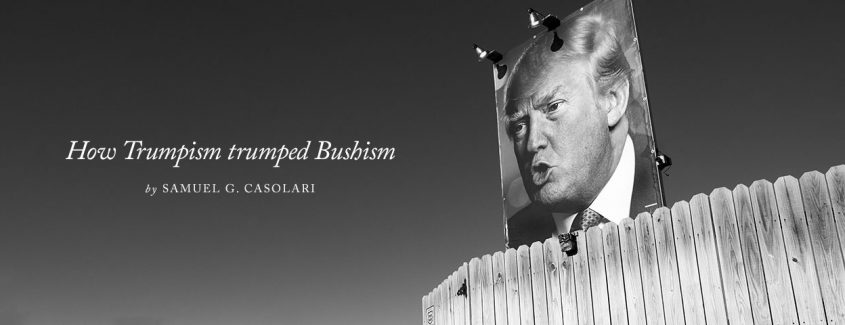
When Ronald Reagan chose George H. W. Bush as his running mate in 1980, a decades-long dance among the Bush family, the Republican establishment, and the conservative movement began. Without a doubt this one choice set the stage for two Bush presidencies, two Bush governorships, and the collision of the sense and sensibilities of those who gave Donald Trump the Republican nomination for president in 2016.
The politics of the five Bush presidential campaigns since 1988 sought conservative support while wrapping it in so-called “kinder, gentler” and compassionate terms. Many conservatives chose to support these campaigns and invest in subsequent administrations. What came of these administrations was a mix of big-government programs and support for globalism: Chamber of Commerce Republicanism, attempts at immigration reform, and some of the biggest spending in U.S. history. Along the way the two Bush presidencies involved America in Panama, the Persian Gulf War (1991), the Iraq War (2003), and Afghanistan. The latter two engagements have been long, complicated, and brought disastrous consequences to Middle East stability and domestic politics. In a few instances, the Bush presidencies reached out to conservatives symbolically or through some conservative judicial appointments, but both presidencies lacked a coherent conservative agenda.
Each Bush presidency was followed by a letdown. Conservatives were not happy and many working-class voters felt that their cares and concerns were ignored. In 1992, both Pat Buchanan and Ross Perot tapped into the angst. Bill Clinton became president as a reaction to the first Bush presidency. This, in turn, brought Hillary Clinton to the national stage. In 2008, Barack Obama tapped into the unpopularity of the second Bush presidency. Each Bush presidency was followed by a more liberal Democratic presidency, and liberal overreach leading to such programs as Obamacare.
As in 1994, after the reaction to the liberal overreach of the Clintons, the 2010 elections reversed the overreach of President Obama and the Democratic majorities. Republicans, energized by the Tea Party, swept congressional and state elections into historic victories. By 2014 these conservative victories finally captured control of the U.S. Senate.
For conservatives and especially the base of the Republican Party, these victories were hollow. Republican leaderships did nothing to advance a conservative reform agenda, and cynicism grew when promises were not kept or even ideas advanced. This combined with No Child Left Behind, Medicare Part D, Tarp and explosive spending in the second Bush presidency, left the base of the Republican Party dispirited, cynical, and opposed to insiders.
Indeed, those who opposed immigration reform were called nativists, those who stood squarely for reform in Congress were derided as wacko birds, and those who questioned aggressive military involvement in the Middle East were called isolationists. More and more, the Republican leadership and establishment separated from its voters. So much so that when Jeb Bush ran for president the donor class invested over $100 million to elect a man who came to symbolize the establishment and the politics of his family. Then came Donald Trump to take the anger and separation and slay Bushism once and for all. And did he ever.
Where Bushism seemed comfortable in the board room, or among international diplomats, or with Fortune 500 donors, or sending messages of pale pastel “compassionate conservatism,” Trump channeled the anger of what Amity Shlaes called the forgotten man. These are the people in the union hall in Steubenville, the waitress in Cambridge, Ohio, or the persons that go to the churches which make up the skyline in Zanesville, Ohio. Forgotten by those who exercise the levers of financial and political power in New York and Washington, these voters rose up against not only Jeb Bush but the whole philosophy behind global trade agreements, new world orders, and the political correctness of elite opinion. They found a champion in Donald Trump. In one election the delicate dance of Bushism came to an end and Republican elites were punished.
The delicate balance of government friendly, big-business oriented, managed-trade agreements and big-government Republicanism that came to embody Bushism came to an end in 2016. Trumpism is the reaction. But what of conservatism? Long since discarded as a governing philosophy, conservatism is the real loser. Forgotten by the Bush presidencies and nowhere in sight as a governing philosophy of Trumpism, those who value liberty and freedom and a nation ruled by law are the real losers. None of the major party candidates in 2016 will present a vision that seeks to restore the balances of constitutional government, open markets and opportunities for all people, and respect the traditions, liberties, laws, and morals of a great nation secure in its borders.
The dance that began in 1980 has come to an end. Now, this election will determine if Trumpism is here to stay, or if there will be a second Clinton presidency.

